
June 18, 2019
Organization of scientific events
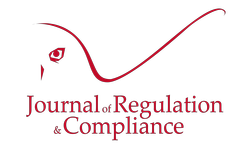
As the previous cycles devoted to the general theme of Compliance and aiming to build a "Compliance Law", having the same vocation to be published in the series Regulation & Compliance, co-published by the Journal of Regulation & Compliance (JoRC) and the Editions Dalloz, this cycle takes a particular aspect of this branch of the Law being built and developed, which was applied even before being conceived. Since pragmatism preceded or even prevailed, the theme chosen this year is: Les outils de la Compliance (Compliance Tools).
These conferences will be in French
These tools are very diverse, not only among themselves but according to the sectors in which they are deployed or according to the geographical areas in which they are applied. It is necessary to apprehend them by going beyond the description of the instrument literally shown, as the texts or the promoters show it, without immediately going up to too large generalities. For this reason, some conferences will focus on specific, well-identified mechanisms, such as risk mapping or alert. They may also consider how Compliance Law uses more general tools to achieve its goals, such as lawsuits, incentives or new technologies. This will make it possible to problematize more clearly perceptible difficulties in Compliance Law, such as the adequacy or inadequacy of the constraint in relation to the aims, the consideration or not of the legal and political geography, the articulation or not of the tools between them.
These various conferences will take place in several places, according to the part taken by the different university structures that this year contribute to the Journal of Regulation & Compliance (JoRC) for the realization of the cycle. The result will be two books, one in French: Les outils de la Compliance, the other in English: Compliance Tools.
This cycle of conferences about Compliance tools will begin in November 2019 and will last until June 2020.
- First conference: 28 November 2019, La cartographie des risques (Risk Mapping), Sciences po. This conference will be in French. Its publication will be in French and in English.
- Conditions of inscription (in French).
- Calendar of the entire conferences.
Le Journal of Regulation & Compliance (JoRC) works with :
- The School of Public Affairs of Sciences Po,
- The Department of Economics of Sciences po,
- The École de Droit of the Panthéon-Sorbonne University (Paris I),
- The École doctorale de Droit privé of Panthéon-Assas University (Paris 2),
- The Centre Perelman of l'Université Libre de Bruxelles,
- The GREDEG of the Sophia-Antipolis University (Nice),
- The Centre Louis Josserand of the Faculté Lyon III.
- The Faculté de Droit of Toulouse,
- TheFaculté de Droit of Clermont-Ferrand.
This cycle of conferences is supported by :
May 29, 2019
Editorial responsibilities : Direction of the collection "Regulations & Compliance", JoRC & Dalloz
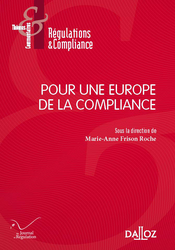
♾️ follow Marie-Anne Frison-Roche on LinkedIn
♾️ subscribe to the Newsletter MAFR Regulation, Compliance, Law
____
► Full Reference: M.-A. Frison-Roche (ed.), Pour une Europe de la Compliance (For the Europe of the Compliance), series "Régulations & Compliance", Dalloz, 2019, 124 p.
____
This volume is the continuation of the books dedicated to Compliance in this collection.
📚Read the other books' presentations of the collection about Compliance:
🕴️M.-A. Frison-Roche (ed.), 📕La juridictionnalisation de la Compliance, 2023
🕴️M.-A. Frison-Roche (ed.), 📕Les Buts Monumentaux de la Compliance, 2022
🕴️M.-A. Frison-Roche (ed.), 📕Les outils de la Compliance, 2021
🕴️N. Borga, 🕴️J.-Cl. Marin &🕴️J.-Ch. Roda (ed.), 📕Compliance : l'Entreprise, le Régulateur et le Juge, 2018
🕴️M.-A. Frison-Roche (ed.), 📕Régulation, Supervision, Compliance, 2017
🕴️M.-A. Frison-Roche (ed.),📕 Internet, espace d'interrégulation, 2016
📚Read the presentations of the other titles of the collection.
____
► General presentation of the book: This book is written in French. The topic is : "For the Europe of the Compliance".
See below its general presentation in English.
The political dimension is intrinsic to the Compliance Law. Indeed, compliance mechanisms consist of internalizing in certains companies the obligation to implement goals of general interest set by Public Authorities. These public bodies control the Ex Ante reorganization that implies for these companies and punish Ex Post the possible structural inadequacy of these compagnies, becoming transparent for this purpose.
This new mode of governance establishes a continuum between Regulation, Supervision, Compliance (book published in 2017) and renew the links between Companies, Regulators and Judges!footnote-1600.
This political dimension must be increased: the Compliance Law of Compliance must today be used to build Europe.
One can observe not only the construction of the European Compliance Law, object-by-object, sector-by-sector, purpose-by-purpose, but also the construction of the European Compliance Law that transcends and unifies them. Becoming independent of American Law and ceasing to be in reaction, even on the defensive, the Compliance Law contributes to the European project, offering it a higher ambition, that Europe can carry and, by this way, can carry the Europe itself, not only to preserve the European economy from corruption or money laundering, but by claiming the protection of nature and human beings.
This is why the book describes the "reasons and objectives" of the Europe of the Compliance, which makes it possible to describe, detect and even predict the ways and means.
____
► Understand the book through the Table of Contents and the summaries of each article:
🕴️M.-A. Frison-Roche, 📝Avant propos
🕴️K. Lenaerts, 📝Le juge de l'Union européenne dans une Europe de la compliance
🕴️M.-A. Frison-Roche, 📝Un droit substantiel de la compliance, appuyé sur la tradition européenne humaniste
I. LES RAISONS ET LES OBJECTIFS D'UNE EUROPE DE LA COMPLIANCE (THE REASONS AND OBJECTIVES OF THE EUROPE OF THE COMPLIANCE)
🕴️X. Musca, 📝Construire une Europe de la compliance en donnant une meilleure place aux entreprises
🕴️P. Vimont, 📝La place de la diplomatie dans l'avancée d'une Europe de la compliance
🕴️P. Sellal, 📝Les vertus de la compliance : une réponse possible aux faiblesses de l'Union européenne ?
🕴️J.-J. Daigre, 📝Compliance, entreprise et Europe
II. LES VOIES ET MOYENS D'UNE EUROPE DE LA COMPLIANCE (THE WAYS AND MEANS OF THE EUROPE OF THE COMPLIANCE)
🕴️J.-Cl. Marin, 📝Quels outils pour la construction du droit de la compliance en Europe ?
🕴️M. Canto-Sperber, 📝La compliance et les définitions traditionnelles de la vertu
🕴️T. Bonneau, 📝Compliance et secteur bancaire et financier en Europe
🕴️C. Duchaine, 📝L'Agence française anticorruption, à l'appui de l'Europe de la compliance
🕴️D. Martin, 📝Les contraintes et les vertus de la compliance
🕴️A. de La Cotardière, 📝Construire une Europe de la compliance lisible pour les entreprises
________
May 14, 2019
Conferences

Référence complète : Frison-Roche, M.-A., participation à la table-ronde L'officier public ministériel est-il soluble dans la blockchain?, conférence-débat organisée par Le Club du Droit & le Conseil supérieur du Notariat, 14 mai 2019, Paris.
Consulter la présentation générale du colloque.
Consulter le document de travail sur la base duquel l'intervention a été faite.
Lire le compte-rendu qui en a été fait dans la presse.
Dans cette table-ronde, un professeur d'économie expose la dimension technologique et économique de la blockchain.
Puis est abordée la dimension juridique, dont l'exposé m'était plus particulièrement confié.
_____
A ce titre, après avoir replacé la question technique dans ce que doit garder le Droit, à savoir la distinction entre la Personne et les choses, ce que la technologie présentée aujourd'hui comme un ensemble de choses "intelligentes" et "décidantes" remettant en cause...., l'intervention porte sur 4 points (qui sont développés dans le document de travail).
En premier lieu, avant de porter une appréciation sur ce qui est adéquat et sur l'avenir il faut distinguer les fonctions techniques de conservation des actes, de duplication des actes et d'élaboration des actes, la distinction entre negotium et instrumentum n'étant en rien effacée par la technologie des blockchains.
En deuxième lieu, dès l'instant qu'il y a une altération substantielle de l'acte instrumentaire parce qu'un nouveau negotium a eu lieu, parce que les mentions doivent mesurer la reproduction de la réalité de ce qui fut décidé par les parties, l'on n'est plus dans l'acte de conserver et de dupliquer à l'identique, mais dans l'acte d'élaboration. Or, dans l'acte de conservation et de duplication, la blockchain peut être un atout technologique très précieux, en ce qu'à supposer sa fiabilité acquise, l'erreur étant exclue, c'est comme si l'on pouvait produire des originaux indéfiniment. La fiabilité est telle que la distinction entre original et copie n'aurait plus lieu d'être. Mais pour l'élaboration de l'instrumentum au regard du negotium , comment une machine pourrait-elle "dresser" un acte, c'est-à-dire en vérifier son rapport d'exactitude par rapport à la réalité ? Elle ne le peut pas. Seul un être humain le met, l'Etat ayant "déconcentré" son pouvoir de dresser uniléralement des actes (en cela, les notaires sont issus de la même idée de déconcentration....) en exigeant qu'ils vérifient la conformité à la réalité pour que l'incontestabilité soit ensuite attachée aux mentions.
En troisième lieu, il apparaît alors que la blockain est un outil de conservation et de duplication, mais que l'intermédiation d'un tiers de confiance humain vérifiant l'exactitude des mentions est nécessaire si l'on veut par sécurité que ce qui est dit dans l'acte écrit, puis conservé, puis dupliqué, soit la reproduction de la réalité. S'opère alors un choix de politique économique, souvent lié à la culture des pays. L'on peut considérer que le coût de l'intermédiation est élevé et qu'il faut mieux assumer le risque de l'inexactitude des mentions (quant aux parties, à la réalité de leur consentement, à la consistance de l'objet, à l'ampleur des obligations, etc.) et s'assurer ainsi un marché liquide. Le réajustement des actes par rapport à la réalité des choses se fait alors par la crise, qui réinjecte l'information, l'exemple en étant la crise des prêts immobiliers financiarisés des subprimes. C'est le choix anglais et américains. L'on peut préférer la sécurité par l'intermédiation en ralentissant le marché. C'est le choix du droit romano-germanique. Ces options demeurent ouvertes. La technologie du blockchain n'interfère pas, parce qu'elle ne doit pas viser l'établissement des actes. Si elle devait la viser, alors on aurait choisi la liquidité à la sécurité. Ou en termes plus généraux, l'on aurait choisi la Concurrence contre la Régulation. Mais plus que jamais le souci Ex Ante des risques systémiques (et le fossé entre la réalité et les actes qui doivent la transcrire est un risque systémique majeur) est premier.
En quatrième lieu, en ayant ainsi un tableau des fonctionnalités, l'on voit que les notaires peuvent avoir grand usage des blockchains. Sans laisser des machines établir des actes, ils peuvent les utiliser comme le furent des coffreforts et des photocopieuses, avec une fiabilité et une mise en commun que seul le numérique et la capacité de calcul peuvent offrir à travers cette nouvelle technologie. Plus encore, l'articulation de l'amont (élaboration) et de l'aval (conservation et duplication) étant de nouveau reconnue comme la plus efficace, les officiels ministériels sont les mieux placés, en tant qu'ils dressent des actes instrumentaires dont ils ont vérifié les mentions et après avoir conseillé les parties, à conserver et à dupliquer ceux-ci.
_____

Updated: May 3, 2019 (Initial publication: Feb. 7, 2019)
Publications

This working paper has served as a basis for an article subsequently published in French in the Law Journal Recueil Dalloz (see Compliance et personnalité, Recueil Dalloz, 2019).
It is enriched with notes, references and links.
Summary: Compliance Law is often presented as empty and a mechanical set of procedures, in which human beings do not matter. It is the opposite.
The concern of human beings justifies it fights against the legal technique of the personality. Indeed as Compliance Law is an legal construction around Information and even in its core function of prevention of the systemic risks and its markets protection, the Compliance Law sets the requirement to know "genuinely" the person who is "relevant" - behind the legal person - for the purpose set, for example the fight against corruption or money laundering, establishing in principe what are only exception in Corporate Law or Competition Law.
In a more European conception of Compliance Law, as Law of direct protection of human beings beyong legal personnalities, from near the company and even far, humans being the real and effective beneficiaries of the new branch of Law.

Jan. 2, 2019
Publications

► Référence complète : M.-A. Frison-Roche, "What can Compliance Law build relying on the European Humanist Tradition", Working Paper, January 2019.
____
This working paper has served as a basis for an article published in French in the collective publication Pour une Europe de la Compliance in the serie Regulation & Compliance.
____
Compliance is often presented as a complex, technical, almost incomprehensible set, in that it consists only of empty and moving procedures, mechanical corpus about which the goal would be a question that would not arise.
The question of the purpose of these huge compliance devices might not even have to be asked. And this for two reasons.
Firstly it would only be a matter of following "processes", that is, mechanical and endless procedures. This conception of compliance is often called "kafkaes". Closer to closer, one thinks first of all of the book written by Kafka's The trial l and Welles' adaptation to the cinema in which the charcters are surrounded by walls that are narrowing around them, but it is rather to his novel In the penal colony that must be thought, that is to say to a procedural system of isolation which we do not understand the foundation, which makes it without foundation and without end but also which takes mainly the form of a machine in which the person is placed and which mechanically writes the Law on and under the skin of his back. This internalization of the rule in the body of the condemned - that the French legal system before the French Revolution associated only with "enormous crimes" - being the ordinary way of actual and ordinary application of the rules can correspond to a certain vision of the Compliance, detached from any purpose.
The question of the purpose of Compliance may also not have to arise for a second reason, almost the opposite: they would always be devices that are specific to particular sectors. Thus, the banking sector, the insurance sector, the drug sector, the agri-food sector, the telecommunications sector, the energy sector, etc. Then the opposite happens: too many goals! Since each of these sectors has specificities such that it includes purposes that are specific to each of them. For example continuity for energy, access information for telecommunications, control of systemic risk for banking and finance, protection and secret for private information, etc. Now, either these ends so diverse are indifferent to each other, or they can contradict each other. Therefore, to ask the question of the purpose of compliance mechanisms would be to move to the stitution of not even trying to understand "processes" to be exceeded by too many substantial purposes pursued at the same time and in contradictorily senses ... .
This is why the question of the purpose of the Compliance is not asked in a main way. Even less if it is superimposed with another goal that is the European construction ....
But on the contrary, if we confront this question of the aims of the Compliance Mechanisms by crossing it with another issue, older but also under construction, namely the question of Europe, it is possible to make an alliance of these two difficulties to transform them as an asset. That one can help the other. Indeed, both Europe and Compliance in their current states are two constructs with uncertain goals or behaviors most often only "reactive" (I). If we do not want to mobilize all our strength to limit our weakness, which leads rather to feed it, we can go draw on the unity of this Europe so diverse but which finds it unity in the protection of the human being by the very idea of "person". However, Compliance Law can have the same unity, despite the diversity of sectors, and thus fill the meaning of these multiple procedures, providing the balance between information and secrets, circulation of data and conservation of that they concern, common and dialectic purpose that this European Compliance Law. in the process of being constituted can give the world an example in relying on the European tradition (II).
Oct. 9, 2018
Conferences

Référence générale : Frison-Roche, M.-A., Participation à la plénière d'ouverture : Regtech, une définition en constante évolution, in Cercle Montesquieu & Open Law en partenariat avec La LJA, La technologie pour une application efficace de la règlementation, Paris Regtech Forum, Paris, 9 octobre 2018.
Regarder la vidéo d'une partie de l'intervention de Marie-Anne Frison-Roche
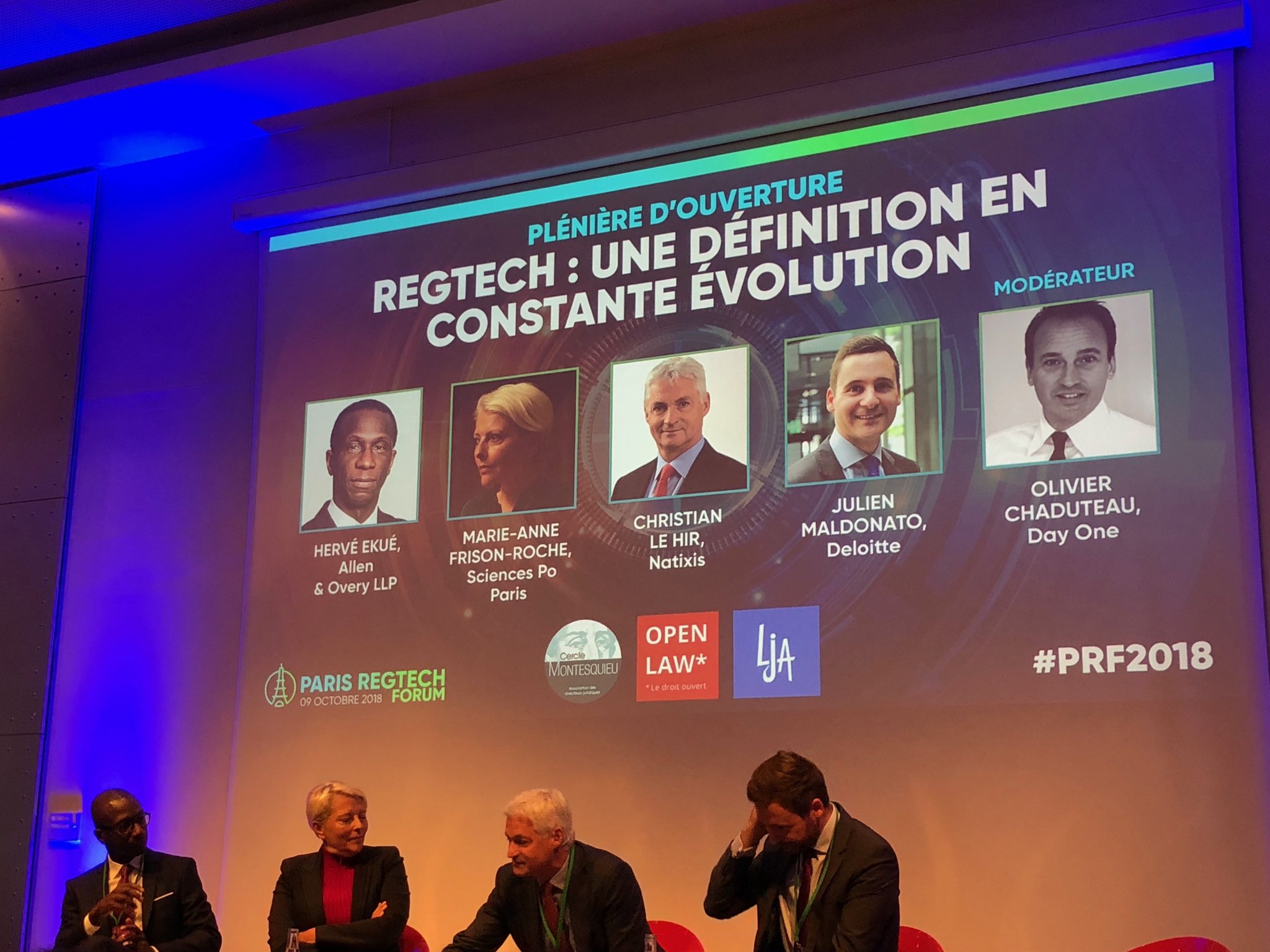
Lors du débat plénier qui ouvre la manifestation ont été abordées les questions suivantes : Qu’est-ce qu’une RegTech ? Quelles sont leurs applications ? Sont-elles les nouveaux business partners des directions juridiques… Pourquoi ne peut-on/doit-on pas les ignorer ?
Pour ma part, j'ai développé que
- les RegTech doivent distinguer des Fintech, non pas en tant qu'ils sont plus étroits que ceux-ci, mais au contraire plus larges. Ils ne doivent pas se limiter à la "réglementation" d'une part et ne doivent en rien se limiter aux secteurs bancaire et financier, mais se saisir de tous les autres secteurs, notamment énergétique, télécom ou pharmaceutique, voire aller dans le transversal comme l'environnement.
- Plus encore les RegTech sont en lien avec la "Compliance", laquelle n'est pas davantage une sous-partie des "RegTech" et c'est pour cela qu'il est approprié de développer d'une façon articulée mais autonome des "ComplianceTech" ou "ComplyTech", en tant que celles-ci doivent pouvoir par la technologie mais sans se dissoudre dans celles-ci centrer l'acculturation dans l'entreprise et par l'entreprise de ce qu'il continue de continuer à appeler le Droit (et non pas la "réglementation") à savoir la préservation des êtres humains et de ce dont ils ont souci : la préservation de la nature et des autres êtres humains.

Oct. 4, 2018
Publications
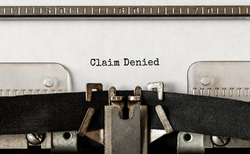
This working paper serves as the basis for an intervention in the conference held at the Collège de France.
Read the presentation of this conference (made in French).
SUMMARY :
For the moment, Compliance can be considered as almost "nothing" because in Europe Compliance is just a "reaction", verty technical, costly and empty against the U.S.(I). And for the moment, we only see one accumulation of mechanical sectorial constraints guided by the concern of efficiency, without associating this to the construction of the Europe .(II) On the contrary, what is before us, the tools and actors being already available : formulating the political goal of the Compliance Law: building Europe, a market where the center is the Person (III.

Oct. 1, 2018
Publications
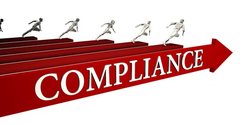
► Full Reference: Frison-Roche, M.-A., Competition Law & Compliance Law , Working Paper, October 2018.
____
► this Working Paper has served as basis for an Article published later in French in the Review Concurrences ; read the presentation in English of this Article.
____
► Summary and introduction : Compliance Law is a new branch of Law, still under construction. One can have a "narrow definition" of seeing it as the obligation of businesses to show that they are constantly and actively complying with the law. One can have a richer definition, of a substantive nature, defining it as the obligation or the own will of certain companies to achieve "monumental goals" that go beyond economic and financial performance.The Competition Law partly integrates its two conceptions of Compliance: Precursor, the Competition Law concretizes dynamically the first conception of the Compliance Law (I) It is with more difficulties but also much more future that the Competition Law can express in dialectic the second conception of the Compliance Law as internationalization of these "monumental goals", especially in the digital space (II).

Updated: Sept. 1, 2018 (Initial publication: May 10, 2018)
Publications
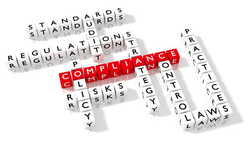
This working paper has served as a basis for an article written in French in the book Compliance : Entreprise, Régulateur, Juge ("Compliance: Enterprise, Regulator, Judge"), published in May 2018 in the Regulations Series of Dalloz editions (Paris).
See the other books published in this collection (presentation in French), directed by Marie-Anne Frison-Roche (presentation in English).
ABSTRACT: The Company, the Regulator and the Judge are three key figures for the construction of an emerging Compliance Law. An important risk lies in a confusion of their respective roles, the company becoming a regulator, the regulator becoming a board of a place that goes to the conquest of others, the judge standing back. It is appropriate that each plays his role and that their respective function is not distorted. If this confusion is avoided, then the points of contact can multiply and one observes it. But as soon as everyone remains in its place, we can go further than these points of contact and if they agreed, the three characters can reach common goals. This is all the more legitimate since Compliance Law, as Regulation Law, is teleological in nature, which makes these branches of law profoundly political. These common goals are technical, such as risk prevention. They can be more political and higher, if there is a shared will, without ever one of the characters being captured by another: it is then to concern by the human being. The designation of this common goal to the Company, the Regulator and the Judge can be expressed in one word: Europe.

Updated: May 30, 2018 (Initial publication: Sept. 23, 2017)
Publications

This working document served as a basis for a lecture given in French at the Académie des Sciences morales et politiques (French Academy of Moral and Political Sciences) on September 25, 2017, in the cycle of conferences conducted under the presidency of Michel Pébereau, Quelles réformes ? (What reforms?)
Consult the presentation (in French) of the conference cycle (2017).
It served as the basis for the publication of an article published in French in 2018 in the book directed by Michel Pébereau Réformes et transformations (Reforms and transformations).

March 1, 2018
Organization of scientific events
Organisation scientifique et organisation du cycle de conférences "Pour une Europe de la Compliance"
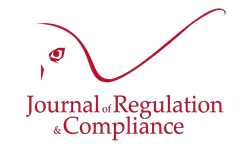
Le cycle de conférences Pour une Europe de la compliance débutant le 2 mars 2018 est organisé par le Journal of Regulation & Compliance (JoRC), en collaboration avec l’École d'affaires publiques de l’École d’Affaires Publiques de Sciences po (Paris), le Département d’Économie de Sciences po,,École de Droit de l'Université Panthéon-Sorbonne (Paris I), l’École doctorale de Droit privé de l'Université Panthéon-Assas (Paris II) et les Éditions Dalloz.
__________
Consulter la présentation générale du cycle
Consulter la liste des conférenciers.
Consulter les informations relatives aux conférences :
Consulter la manifestation publique du 2 mars 2018.
Consulter la manifestation publique du 12 avril 2018.
Consulter la manifestation publique du 30 mai 2018.
Consulter la manifestation publique du 7 juin 2018.
Consulter la manifestation publique du 6 septembre 2018.
Consulter la manifestation publique du 4 octobre 2018.
Consulter la manifestation publique du 15 novembre 2018.
Consulter la manifestation publique du 13 décembre 2018.
Feb. 22, 2018
Thesaurus : Soft Law
Sept. 8, 2017
Compliance and Regulation Law bilingual Dictionnary
Jan. 7, 2016
Compliance and Regulation Law bilingual Dictionnary

Capture is a term usually used in economic theories and refers to the situation in which an institution, in particular the Regulatory Authority, loses its independence by the influence exerted by a third party on it. The extreme case of capture is corruption, whereby an operator appropriates the decision-making power of the public Autority. But capture by corruption is paradoxically not the most dangerous situation, although under Criminal Law, for it is the most visible and - if the whole economic system is not corrupt - this corruption can be combated, for example by the change of those who govern the regulatory authority. Capture is more problematic when it is insidious. Thus, the sector can capture the Regulator by compromise when the people who are in the companies are the friends of the people who are in the regulatory authorities, for example when they have at the time of their studies attended the same schools, or when they later frequented the same clubs, practiced the same sports, or else when they were in their careers went from regulatory institutions to business and vice versa by the way, through consulting or lawyers firms.
In addition, capture can be done not by maneuvering on men but on things. Indeed, to capture the Regulator , it is necessary but it is enough not to give him the information that he needs, or to give the bad information to him. The asymmetry of information increases the risk of the regulator's capture, which explains why the financial Regulator is particularly exposed. Thus, the more technical the sector is, the more likely it is that the Regulator will be caught (for example in nuclear matters, where defense secrecy is opposed to the very idea of information, without the idea of morality of humain beings ou the idea of corruption necessarily interfere).
However, if the Regulator is captured by the sector, the regulatory system itself collapses. The function of the Regulator is to control the sector on an ongoing basis, in order to take ex ante the appropriate norms or issue an opinion in this respect and to punish in ex post the breaches that the regulatory body has been able to establish, but its capture prevents this office from being fulfilled. This is why the capture of the Regulator is the obstacle that annihilates the entire Regulatory system.
Dec. 5, 2004
Thesaurus : Doctrine
Référence complète : Tuot, Th., La sauvegarde et l'adaptation de la hiérarchie des normes en matière de régulation, in Frison-Roche, M.A. (Dir.), Règles et pouvoirs dans les systèmes de régulation, coll. "Droit et économie de la régulation", Presses de Sciences Po et Dalloz, 2004, pp. 74-76.